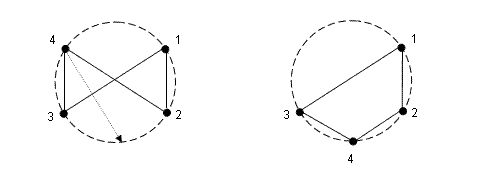
2. Text problem 6.1.
3. Text problem 6.4.
4. A classic ice-breaking exercise is for a group of n people to form a circle and then arbitrarily join hands with one another. This forms a "human knot" since the players' arms are most likely intertwined. The goal is then to unwind the knot to form a circle of players with no arms crossed.
We now adapt this game to a more general and more abstract setting where the physical constraints of the problem are gone. Suppose we represent the initial knot with a 2-regular graph inscribed in a circle (ie, we have a graph with n vertices with exactly two edges incident on each vertex). Initially, some edges may cross other edges and this is undesirable. This is the "knot" we wish to unwind.
A "move" involves moving any vertex to a new position on the circle, keeping its edges intact. Our goal is to make the fewest possible moves such that we obtain an n-sided polygon with no edge-crossings remaining.
For example, here is a knot on 4 vertices inscribed in a circle, but two edges cross each other. By moving vertex 4 down to the position between 2 and 3, a graph without edge-crossings emerges. This was achieved in a single move, which is clearly optimal in this case.

When n is larger, things may not be quite as clear. Below we see a knot on 6 vertices. We might consider moving vertex 4 between 5 and 6, then vertex 5 between 1 and 2, and finally vertex 6 between 3 and 4; this wins in 3 moves.

But clearly we can solve the same knot in only two moves:

The input consists of a number of cases. Each case starts with a line containing the integer n (3 <= n <= 500), giving the number of vertices of the graph. The vertices are labelled clockwise from 1 to n. Each of the next n lines gives a pair of neighbors, where line i (1 <= i <= n) specifies the two vertices adjacent to vertex i. The input is terminated by n = 0.
For each case, if there is no solution, print "Not Solvable" on a line by itself. If there is a solution, print "Knot Solvable" on a line by itself, followed by the minimum number of moves required to solve the problem, on a line by itself.
6 4 5 3 5 2 6 1 6 1 2 3 4 6 2 6 1 4 5 6 2 5 3 4 1 3 6 2 6 1 6 4 5 3 5 3 4 1 2 0
Knot Solvable 2 Knot Solvable 1 Not SolvablePlease write a solution to this problem and submit your program and your outputs for the test cases in this file.